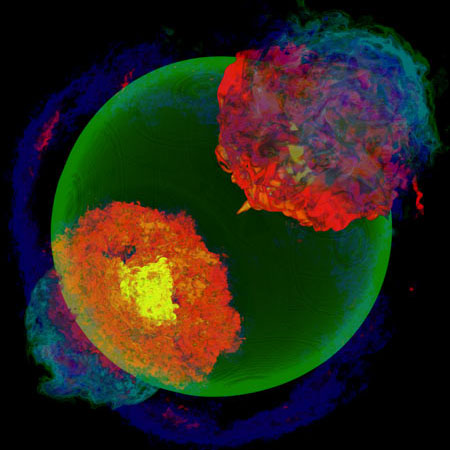Exploding White Dwarf Star

Image credit: Flash Advanced Simulation and Computing (ASC) and
Academic Strategic Alliances Program (ASAP) Center
In this image, the white dwarf star is shown with a green surface. The burned ash is moving over the surface of the star in outward rings moving towards the poles. Temperature variations are shown by color, with yellow indicating the hottest areas and blue the coolest.
Astrophysicists are able to "explode a star" in a virtual computational laboratory by applying physics to calculate the mechanism and progression of the explosion.
Using U.S. Department of Energy (DOE) supercomputers, scientists at the Flash Center (DOE/NNSA ASC Alliance Center for Astrophysical Thermonuclear Flashes at the University of Chicago), successfully demonstrated a 3-D detonation of the thermonuclear explosions of white dwarfs for the first time. Of course they couldn't directly explode the stars in the lab. The research was performed using detailed simulations. These are shown in a several second movie depicting the fascinating steps in gravitationally confined detonation (GCD) of a white dwarf explosion (a Type Ia supernova).
The scale of this event is mind bending. The radius of the white dwarf shown is similar to that of the Earth's moon, and contains a mass equivalent to 1.4 times the mass of our sun. The density is enormous, exceeding 2 million tons per cubic centimeter. The power of the resulting supernova explosion is almost unfathomably large -- the energy released by the explosion is equivalent to an octillion (that is, a one followed by 27 zeroes) powerful nuclear bombs. The entire duration of the explosion process shown -- from initial flame spark to detonation -- is two seconds of real time.











